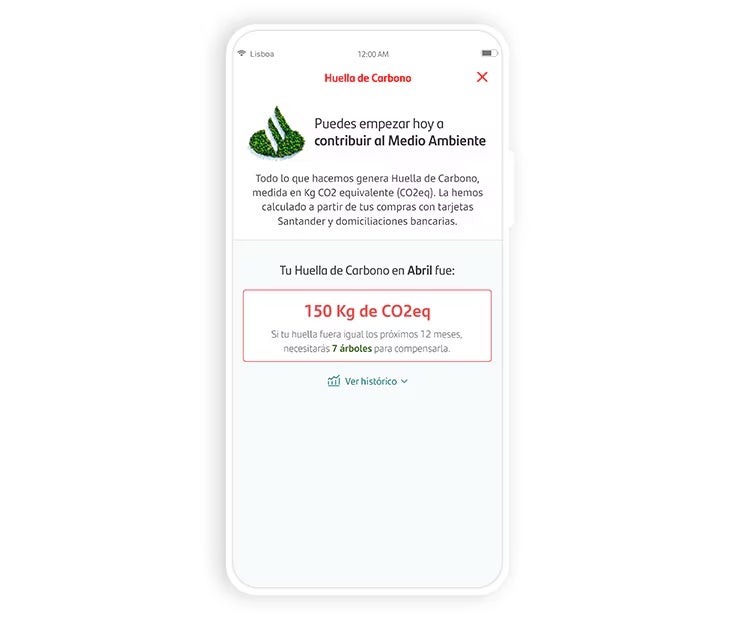
1
Take a look at your footprint and its tree equivalent.

2
Take a look at the breakdown of your footprint by categories.

3
We give you advice to reduce your footprint.
Sustainability
Do you know how much CO2 you generate? We help you be aware of your carbon footprint, offset it and reduce it.

On a daily basis, all of our activity generates greenhouse gas emissions, which build up in the atmosphere and are responsible for climate change.
The name carbon footprint has been coined for all the emissions generated directly or indirectly by a person, organisation, event or product. Did you know that you can estimate the impact of your footprint by the purchases and direct debits you make? They are associated with a carbon footprint expressed in tonnes of CO2 equivalent (CO 2) emitted.
At Banco Santander we have been working with Factor CO2, a consultant specialising in climate change, to develop a methodology to calculate the CO2eq emissions associated with each of your transactions (credit cards, debit cards and direct-debit charges), depending on the amount in euros and on the sector of activity associated with each.
We exclude purchases from international retailers and at any establishments which already offset their carbon footprint, and any cash payments you make.
This methodology has been reviewed by the consultant KPMG. The entire calculation process is carried out internally, in strict compliance with current regulations on data protection and with the bank's privacy policies, and no information or customer data are shared at any time
Compensation is not a measure to substitute reduction of the carbon footprint, but acts as a complement for the remaining emissions that cannot be reduced at the present time. At Banco Santander, via the Climatetrade1 company, we offer you the possibility of offsetting your carbon footprint by purchasing carbon credits.
Each carbon credit is a tonne of CO2eq prevented or mitigated in the atmosphere. You can offset per kg of CO2eq. When you offset your footprint by buying carbon credits, they will be locked out and cannot be used by other individuals or companies.
The cost of carbon credits is directly related to the cost of the project that generates them, and so this could vary according to, for example, its location, its nature, or availability.
Banco Santander provides you with information on your carbon footprint, and some advice and good practices you can apply regularly to reduce it. We invite you to explore the advice available in the consumption categories explained above.
Trees absorb CO2 from the atmosphere and store carbon in their wood as they grow, while they exhale oxygen. This ability to take in carbon from the atmosphere is measured in tonnes of CO2.
Not all trees absorb the same amount of carbon dioxide, and this depends on factors such as their growth maturity, the species and geographic location. It could be estimated that a tree in Spain can absorb an average amount of 250 kg of CO2 over 40 years. So, if you generate 4,000 kg of CO2 in your footprint in one year, you must plant approximately 16 trees so that their lifetimes can offset your footprint over one year, although there are other ways of offsetting this, as you will see below.
Being aware of and measuring your carbon footprint will enable you to quantify the emissions generated by your consumption, and to take measures to minimise your impact: either by directly reducing your emissions (see the advice section), or by offsetting any emissions you have not been able to reduce by buying carbon credits.
Climate change is a reality, and the main environmental challenge facing our planet. It is a problem which affects all of us, and the solution is in our hands: it does not depend on a government, a corporation or individuals, and requires joint collaboration because the responsibility is shared. It does not matter how small you believe your actions are, because the sum of many small actions will generate a positive impact on the environment.
Banco Santander does not extract any economic benefit, and our only benefit is moving forward with our customers and helping to decarbonise the economy. This service aims to provide a space for our customers to make a contribution to protection of the environment and the fight against climate change. Banco Santander is only giving its customers information on their carbon footprint, and offering them the possibility of offsetting it on a carbon credits purchase platform.
Through Climatetrade1 (official intermediary in the voluntary carbon market, with tax no. B87550646 and registered office at G.V. Marqués del Turia nº 49 planta 5, puerta 4, Valencia), you can gain access to a number of offsetting projects generating carbon credits available for purchase (see preceding section). ClimateTrade1 will be tasked with purchasing and effectively withdrawing carbon credits on the European Emissions Register (or any other registers where the assets have been issued), under “Banco Santander customer offsetting project”, and will issue you with a proper certificate to accredit the purchase.
The projects selected and provided for our customers to carry out offsetting have been verified by one of the main international standards analysing this kind of project. In addition to this verification, Banco Santander carries out a further analysis of the projects.
Simplifying matters, a distinction can be made between projects which prevent emissions (e.g. renewable energies which replace pollutant sources with clean energy, or prevention of deforestation), and projects which absorb CO2eq (e.g. reforestation projects or carbon capture through technology). In general, nature-based solutions such as reforestation, management of agricultural land or the conservation of water bodies and wetlands can make an effective contribution to the capture of CO2eq, although the associated cost is usually high.
Among the various options, you can choose from projects in emerging countries or projects with a local impact, and you will see a brief description of the project and the positive impact it generates. In any case, bear in mind that CO2eq emissions have a global effect, and so offsetting with national or international projects means you are making a contribution to the fight against climate change.
At Banco Santander we offset the emissions from our own operations (scope 1 and 2) that we have not been able to reduce. Regarding scope 3 emissions, our current focus is on reducing them. Since 2011, the different initiatives implemented have allowed us to reduce electricity consumption by 38%, CO2e emissions by 69% and paper consumption by 83%. 100% of the electricity used by Banco Santander in Spain is from renewable sources, and corporate buildings in Spain have ISO 14001 and zero-waste certification, at the corporate head office of Boadilla and Santander Spain.
In 2020 Santander Group deployed a plan to offset emissions on the basis of five projects in Mexico, Spain, Brazil, Germany and the United States, focusing on the development of wind power and hydroelectric energy, reforestation and the reduction of emissions of nitrous oxide. In Spain, Banco Santander will make a contribution by planting 275,000 trees to assist with the reforestation of three forests, offsetting more than 82,000 tonnes of CO2eq and creating jobs for 15,000 people, with a particular focus on the inclusion of more vulnerable groups.
Santander Group is also stepping up its initiatives to assist with the transition towards a green economy: world leader in terms of funding for renewable energy projects, issuance of green bonds, commitment to mobilise EUR 120 billion in green funding between 2019 and 2025, and EUR 220 billion up to 2030.
In addition, to support the objectives of the Paris Agreement on climate change, Santander Group has undertaken to achieve zero net carbon emissions (net zero) by 2050, not only in the Group's own operations, but also in due consideration of emissions by customers that may arise from any funding, advisory or investment.
As the data controller, Banco Santander, S.A. estimates its calculation of your carbon footprint on the basis of analysis of the transactions you carry out with your means of payment, and of bills paid through any accounts held by you with the bank.
You will find detailed information on the processing of your data, and also your rights, in the legal notice on the bank's website www.bancosantander.es.
The advice and FAQs you will find in this space are not customised for you, but are general and equal for all customers."
1. Service provided by Climatetrade: CLIMATE TRADE, S.L. with address at Gran Vía Marqués del Turia, 49-5º-4, 46005 Valencia and NIF B-87550646.
Enter here and find answers to the most frequently asked questions with our online help available 24 hours a day.